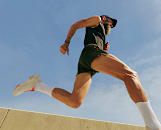
Westend61 via Getty Images
Heel Strike, Midfoot, or Forefoot Running: Everything You Need to Know About Foot Strike
Here's everything you need to know about foot strike when it comes to running.
By Kells McPhillips•
The Connection Between Your Foot Strike and Running
The Different Types of Foot Strikes
How Can You Tell What Type of Foot Strike You Have?
Is Heel Striking a Bad Thing?
How to Change Your Foot Strike
Running is one of the closest things humans have to flying. In between each step, you hover above the ground; for a moment, you have wings. But how you land back on earth may determine how fast and far you go and whether you remain injury-free as the miles roll on. So we asked a couple of experts to break down the strengths and weaknesses of forefoot running, midfoot striking, and heel striking—once and for all.
Discover more ways to reach your goals with Peloton
The Connection Between Your Foot Strike and Running
It goes without saying that your feet are the first thing to touch the sidewalk or treadmill when you run. “The interface between the foot and the ground creates a ‘ground reaction force’ which is what creates forward propulsion and gets us moving from Point A to Point B,” explains Alan Tomczykowski, PT, DPT, a physical therapist at BreakThrough Physical Therapy.
Whether you land on your heels or your toes is important because it determines which muscles and joints will absorb the force of your footfalls. “Your foot strike is an important aspect of running because the position of your foot as it strikes the ground can affect the efficiency of your running,” says Peloton instructor Becs Gentry. “Having a well-positioned foot strike is, in the end, going to make sure that you have a more efficient run and potentially a more comfortable run.”
The Different Types of Foot Strikes
While every runner is slightly different, most people fall into three foot-striking camps: the forefoot runners, the midfoot runners, and the heel runners.
Forefoot Strike
These folks land on the balls of their feet when they run, which is why it’s sometimes referred to as running on your toes. Research shows forefoot running may reduce impact forces on the lower limbs, so it’s the preferred foot strike for sprinting and speed work.
Midfoot Strike
“A midfoot strike is the most preferable strike for an everyday run,” Becs says. “You are landing in the middle of the foot—and then you’re toeing off from there.”
Heel Strike
Heel strikers initiate their steps by placing the heel of their foot on the ground. “Heel striking is a very uncomfortable and potentially hazardous way of running,” Becs says. “It overextends your hamstrings and can lead to a lot more injuries than the other two ways of running.” Heel striking may even lead to injuries such as shin splints or knee pain, which is why many running coaches will try to break the habit when they see it.
Related Articles
How Can You Tell What Type of Foot Strike You Have?
If you pay close attention on your next run, you should be able to feel if you’re meeting the ground with your heel, midfoot, or forefoot. “Just have a look at how you run,” Becs says. “You won't only see what your foot strike is, but you might also see whether your foot is rolling in (pronating) or rolling out (supinating).”
You can also take note of how long your foot remains on the ground, which can give you a good idea of how efficient your foot pickup is. “If you’re spending a long time on the ground, your running efficiency is quite low as well,” Becs says.
Prefer not to do it yourself? You can also formally test your running form at a local sneaker store, where they can record your running gait and analyze how you move forward through space.
Is Heel Striking a Bad Thing?
The research around heel striking is complicated and mixed, but experts generally recommend avoiding it. The first problem with heel striking is that it’s not very efficient, explains Dr. Tomczykowski. “Because the foot is landing in front of us, the leg and foot act as a brake and cause retropulsion. Meaning the ground reaction force is actually working against us, trying to move us backward while the goal remains moving forward,” he says.
Heel striking also makes certain muscle groups, such as the quadriceps, work harder than they need to—which may result in early muscle fatigue. This inefficiency causes us to move slower and places undue stress on our entire body, which could potentially result in injury.
“Heel strike pattern often tends to lead to a ‘clawing’ motion like you are riding a bike and flexing through the knee to create forward kinetic motion, which can create overuse issues like pes anserine tendonitis, among other things,” Dr. Tomczykowski says. (Pes anserine bursitis is inflammation of the three tendons that run along the base of the knee joint.) Heel striking can also lead to other types of injuries, such as Patellofemoral stress syndrome, a broad term for knee pain.

Peloton App
Access thousands of classes with no equipment needed.
How to Change Your Foot Strike
Your body can learn new ways to move—so long as you remain patient, thoughtful, and methodical with your approach.
Whether you’re brand-new to running, hope to practice injury prevention, or are training for your longest distance, now is the time to tweak your form. To get you started, Dr. Tomczykowski shares his favorite approaches for retraining your strike slowly and carefully over time to avoid injury and inefficiency in the future.
1. Focus on Mechanics First
Maybe you’re hoping that switching up your stride will help you run faster or longer distances. While that’s a great long-term goal, Dr. Tomczykowski recommends focusing solely on your mechanical goals in the short term. For example, perhaps your mechanical goals are to swing your arms more and increase your cadence, the number of steps you take per minute.
“Running mechanics are a skill that can be improved upon if someone is willing to put in the time and has the right coaching,” Dr. Tomczykowski says. Ignore speed and distance (for now) and make your desired striking style your new big goal.
2. Start With Short Distances
Say you run five miles three times a week. When you start training your new striking style, you should not try to keep up with mileage. Instead, take a beginner’s approach. During your first week of forefoot running, your goal may be to schedule four workouts where you run three sets of five-minute intervals with a three-minute break between each one. Throughout this workout, aim for proper form above all else.
3. Build Strength in Your Lower Body
On days you're not running, try the classes in the Peloton App—specifically the strength, mobility, and flexibility classes focused on runners. In time, this work will amount to a more efficient running form.
4. Pick the Right Shoes
The shoe you run in can also encourage proper form. “A zero drop minimalist [style] is more aggressive and will promote a forefoot strike pattern,” Dr. Tomczykowski says. “Conversely, a rocker bottom or very cushioned shoe can allow for a heel strike pattern.” He recommends seeing a professional who can look at your foot in gait to determine which sneaker will help you maintain good form as the miles roll on.
5. Consult an Expert
Of course, it’s always best to work on your running mechanics with the help of a trained professional such as a physical therapist or a sports doctor. They can analyze your gait and create a plan tailored to your body and timeline.
“When you start running, a good coach will ask to see how you run in order to train you efficiently,” Becs says. “You may have to change your speed for a little bit just to practice, but it will be worth it because building efficiency as a runner is the best way to enjoy the run.”
This content is for informational and educational purposes only and does not constitute individualized advice. It is not intended to replace professional medical evaluation, diagnosis, or treatment. Seek the advice of your physician for questions you may have regarding your health or a medical condition. If you are having a medical emergency, call your physician or 911 immediately.
Level up your inbox.
Subscribe for a weekly dose of fitness, plus the latest promos, launches, and events.
By providing your email address, you agree to receive marketing communications from Peloton.
For more about how we use your information, see our Privacy Policy.













